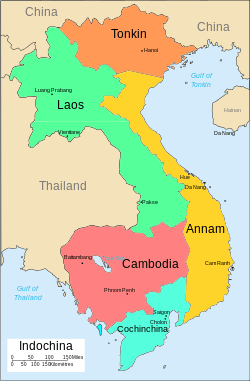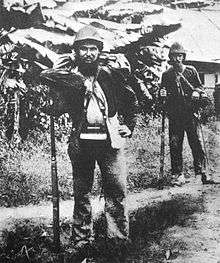French Cochinchina
| French Cochinchina | ||||||||||
| Cochinchine française | ||||||||||
| Colony of France Constituent territory of French Indochina | ||||||||||
| ||||||||||
| ||||||||||
 Cochin-China was the southern part of present-day Vietnam, shaded cyan | ||||||||||
| Capital | Saigon | |||||||||
| Languages | Khmer Cham Chinese French Vietnamese | |||||||||
| Religion | Buddhism (Theravada and Mahayana) Confucianism Taoism Roman Catholicism Animism | |||||||||
| Political structure | Colony | |||||||||
| Historical era | New Imperialism | |||||||||
| • | Established in accordance with Treaty of Saigon | 5 June 1862 | ||||||||
| • | Merged to the Central Government | 4 June 1949 | ||||||||
| Area | ||||||||||
| • | 1868 | 65,478 km² (25,281 sq mi) | ||||||||
| Population | ||||||||||
| • | 1868 est. | 1,214,141 | ||||||||
| Density | 18.5 /km² (48 /sq mi) | |||||||||
| • | 1939 est. | 4,484,000 | ||||||||
| Density | 68.5 /km² (177.4 /sq mi) | |||||||||
| Currency | French Indochinese piastre | |||||||||
| ||||||||||
| Today part of | | |||||||||
| a. Population figure taken from P. Gubry, Population et développement au Viêt-nam (2000), p. 44. | ||||||||||
French Cochinchina, or Nam Kỳ, was a colony of French Indochina, encompassing the Cochinchina region of southern Vietnam.
French conquest
For a series of complex reasons, the French government of Napoleon III, with the help of Spanish troops arriving from the colonial Philippines in the Spanish East Indies, invaded the southern part of Vietnam, then known in the West as Cochinchina. In September 1858, France occupied Đà Nẵng (Tourane). On 18 February 1859, they conquered Saigon and three southern Vietnamese provinces: Biên Hòa, Gia Định and Định Tường; the Vietnamese government was forced to cede those territories to France in June 1862.
The southernmost part of Vietnam, which was until called by the French lower Cochinchina (Basse-Cochinchine) became a colony known as Cochinchina.[1]
Administration
In 1867, the provinces of Châu Đốc, Hà Tiên and Vĩnh Long were added to French-controlled territory. In 1864 all the French territories in southern Vietnam were declared to be the new French colony of Cochinchina, which would be governed by Admiral Marie Jules Dupré from 1871 to 1874.
In 1887, it became part of the Union of French Indochina. Unlike the protectorates of Annam protectorate and Tonkin protectorate, Cochinchina was ruled directly by the French, both de jure and de facto, and was represented by a deputy in the National assembly. Together with Tonkin, it was one of the economic centers of French Indochina.
Fifty-one Vietnamese rebels were executed following the 1916 Cochinchina uprising. In 1933, the Spratly Islands were annexed to French Cochinchina. In July 1941, Japanese troops were based in French Cochinchina (a de facto occupation). After the Japanese surrendered in August 1945, Cochinchina was returned to French rule.

End
In 1945, Cochinchina was ruled directly by the Japanese after they had taken over from the French in March. In August, it was briefly incorporated into the Empire of Vietnam. Later that month, the Japanese surrendered to the Việt Minh during the August Revolution.[2] On September 2, 1945 Việt Minh established Democratic Republic of Vietnam with territory of Annam, Tonkin and Cochinchina.[2] Democratic Republic of Vietnam held the general election on January 6, 1946 in all areas of Vietnam, including Cochichina, in order to establish the first National Assembly in Vietnam.[3]
The Autonomous Republic of Cochinchina (République autonome de Cochinchine), a French puppet state, was proclaimed on his own initiative and in violation of the 6 March Ho–Sainteny agreement by High Commissioner d'Argenlieu on 1 June 1946, whilst the Viet Minh leadership was in France for negotiations.[4] War between France and the Viet Minh followed (1946–54). Cochinchina was renamed the "Autonomous Republic of Cochichina". Nguyen Van Thinh, the first head of its government, died in an apparent suicide in November of the same year. He was succeeded by Lê Văn Hoạch, a member of the caodaist sect. In 1947, Nguyễn Văn Xuân replaced Lê and renamed the "Provisional Government of the Autonomous Republic of Cochichina" as the "Provisional Government of South Vietnam", overtly stating his aim to reunite the whole country.[5] The next year, the Provisional Central Government of Vietnam was proclaimed with the merger of Annam and Tonkin : Xuân became its Prime minister and left office in Cochichina, where he was replaced by Trần Văn Hữu. Xuân and the French had agreed to reunite Vietnam, but Cochinchina posed a problem because of its ill-defined legal status. The reunification was opposed by the French colonists, who were still influential in the Cochinchinese council, and by Southern Vietnamese autonomists : they delayed the process of reunification by arguing that Cochinchina was still legally a colony - as its new status as a Republic had never been ratified by the French National Assembly - and that any territorial change therefore required the approval of the French parliament. Xuân issued a by-law reuniting Cochinchina with the rest of Vietnam, but it was overruled by the Cochinchinese council[6]
Cochinchina remained separated from the rest of Vietnam for over a year, while former Emperor Bảo Đại - whom the French wanted to bring back to power as a political alternative to Ho Chi Minh - refused to return to Vietnam and take office as head of state until the country was fully reunited. On March 14, 1949, the French National Assembly voted a law permitting the creation of a Territorial Assembly of Cochinchina. This new Cochinchinese parliament was elected on 10 April 1949, with the Vietnamese representatives then becoming a majority. On 23 April, the Territorial Assembly approved the merger of the Provisional Government of South Vietnam with the Provisional Central Government of Vietnam. The decision was in turn approved by the French National Assembly on May 20,[6] and the merger was effective on June 4.[7] The State of Vietnam could then be proclaimed, with Bảo Đại as head of state.[6]
See also
- Annam (French protectorate)
- Tonkin (French protectorate)
- French Indochina
- List of French possessions and colonies
- List of administrators of the French protectorate of Cochinchina
- State of Vietnam
References
- ↑ Pierre Brocheux and Daniel Hémery, Indochine : la colonisation ambiguë 1858-1954, La Découverte, 2004, p. 34-35
- 1 2 http://historymatters.gmu.edu/d/5139/
- ↑ http://www.hcmulaw.edu.vn/hcmulaw/index.php?option=com_content&view=article&id=348:cttctn1946-mmslsctcdcvn&catid=103:ctc20061&Itemid=109
- ↑ Frederick Logevall Embers of War Random House 2012 p. 137
- ↑ Philippe Devillers, Histoire du viêt-nam de 1940 à 1952, Seuil, 1952, pp 418-419
- 1 2 3 Philippe Franchini, Les Guerres d'Indochine, vol. I, Pygmalion - Gérard Watelet, Paris, 1988, pp. 399-406
- ↑ Fac-similé JO du 5 juin 1949, French Cochinchina, Legifrance.gouv.fr.
Further reading
- Encyclopedia of Asian History, Volume 4 (Vietnam) 1988. Charles Scribner's Sons, New York.
- Vietnam - A Long History by Nguyễn Khắc Viện (1999). Hanoi, Thế Giới Publishers
- ArtHanoi Vietnamese money in historical context
- WorldStatesmen- Vietnam





